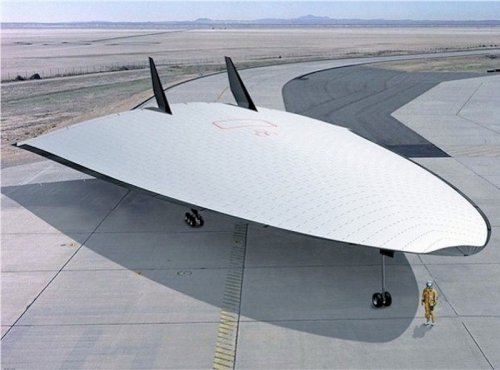Although the March 1999 roadmap by the Air Force for the long-term future of its bomber fleet was criticized on the grounds that the B-52H, B-1B, and B-2 fleets would eventually become obsolete and overstretched, in early June 1999 the USAF's Air Force Aeronautical Systems Center commenced the Future Strike Aircraft (FSA) program awarding year-long study contracts to Boeing, Lockheed Martin, and Northrop Grumman for those companies to investigate designs for a future global strike bomber to be operational by 2030. By September, Northrop Grumman unveiled a series of FSA designs for a new global strike bomber to replace the B-2, and these concepts were grouped into subsonic, supersonic, and hypersonic classes, and speed was emphasized by Northrop Grumman as the key trade-off.
 |
| Left: Three-view of the Northrop Grumman Mach 2 FSA concept Right: Computer-generated image of the Northrop Grumman Mach 4 FSA design |
The subsonic FSA design by Northrop Grumman took the form of a strategic flying wing bomber with a number of refinements to the design of the B-2, although additional published details of this proposal are sorely lacking. Northrop Grumman proposed two FSA designs capable of cruising at speeds within the supersonic flight regime, both resembling a cross between the B-1B and B-2. One was a blended wing body delta-shaped aircraft with small cranked wing extensions, a W-shaped trailing edge of the wings, and outward canted vertical stabilizers, which measured 143 feet (43.58 meters) long and had a wingspan of 118 feet (36 meters). It was powered by two supercruise turbofan engines (unspecified, but probably derived from the Pratt & Whitney F119), which could allow for cruising at speeds of Mach 2 without an afterburner. The other supersonic FSA proposal from Northrop Grumman had a top speed of Mach 4 and inward canted vertical stabilizers, and it was powered by four jet engines housed in two paired nacelles outboard of the vertical stabilizers, functioning as turbofans for low supersonic speeds and operating as turboramjets at speeds of Mach 4. Like the subsonic flying proposal, both Northrop Grumman supersonic FSA designs were stealthy and carried a crew of two, with the weapons load for these aircraft comprised laser-guided bombs, gravity bombs, and cruise missiles carried inside internal weapons bays. Northrop Grumman also envisaged an unmanned version of its subsonic flying wing concept, the Unmanned Global Strike Aircraft, which either could operate autonomously or within a formation of up to four aircraft controlled by a third crewmember in a modified B-2.
Northrop Grumman's hypersonic bomber proposal was arguably the most cutting-edge FSA design to be worked out by the company for the FSA program. It was a futuristic-looking bomber with blunt wings, twin vertical stabilizers, and a nose with a round curvature, and it featured a space capsule-type window, which meant that the pilot had to rely on a visually-aided cockpit requiring sensors even for takeoff and landing. Power was provided by scramjet engines at the rear of the aircraft, and to reach hypersonic speeds, the hypersonic FSA design had to rely on jet- or rocket-assisted climb to very high altitudes, with the scramjet igniting as the engine turbines were sealed off from the incoming air. In order to scout enemy targets over distances of 125 miles (201 km) or more, the hypersonic bomber was equipped with multispectral sensors and a high energy laser with a range of frequencies, and offensive weapons were launched from multiple rails from the rear of the aircraft's vertical tails at hypersonic speeds. Given the astronomically high temperatures associated with hypersonic flight, the Northrop Grumman hypersonic bomber would have been constructed from heat-resistant materials, namely carbon-carbon, Beta-21S aluminum, and lightweight ceramics.
Additional data on Northrop Grumman's bomber designs for the Future Strike Aircraft program can be found at these links:





No comments:
Post a Comment